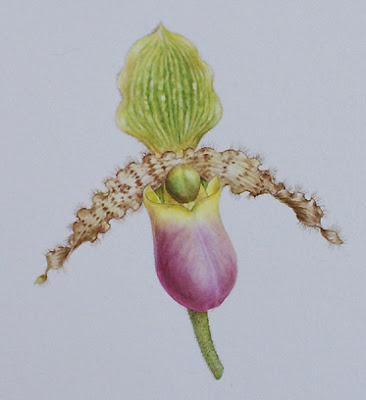Assignment 9. The Botanical Illustration.
Pulsatilla vulgaris. Playing a bit safe really because I've painted it a few times. Again this assignment is worth more in marks with 15 marks.
This one is all about accuracy, not that the others aren't but there's more to measure. All assignments are marked with the same criteria, including on botanical accuracy but also on technique, composition, line and form, tone and colour. labelling of course has to be accurate too. This one will be scrutinised no doubt! My turor Reinhild Raistrick who I had met at the SBA seminar in London and discussed the plant choice, she told me that Pulsatilla grow wild in East Anglia, where she lives and that she has painted them in situ many times, so perhaps I set myself a hard task choosing a plant she is very familiar with! I wanted to paint a native species, it makes labelling compared to all those difficult to identify cultivars, but that's not the real reason, I just prefer native plants I guess..... and they're pretty important!
 |
| Detail showing all the fine hais on the flower stem and leaves, to add hais use a pale botanical grey mix against the white of the paper and add titanium white for hairs against the plant |
I included side view opening bud, front view, seedhead leaves and enlarged reproductive parts and individual enlarged seed. Reproductive parts are lined up along the bottom and labelled neatly with pecil using a 'x' rather than a scale bar. I think I could have included a rear view and closed bud but it's not essential.
 |
| The complete illustration, showing different aspects |
My tutor said that the hue on these flowers is difficult particularly with the hairs but felt I had an accurate match.
The drawing she said was accurate and showed off the nature and shape of the subject to perfection!
She thought the botanical accuracy was 'professional'
For technique the washes and hairs she said were excellent...I've got a red face and big head now!
Composition well balanced and clean with labelling kept to a minimum on the front, as it should be.
The only suggestion was a possible light wash on the leaves to reduce the business.
Wow I was pretty pleased with that feedback and a good mark!
To be fair this is mypreferred type of work , and I should be ok with dissection, measuring and the likes with being trained in Biology. When it comes to mixed florals and card designs I will be in a bit more trouble!








































